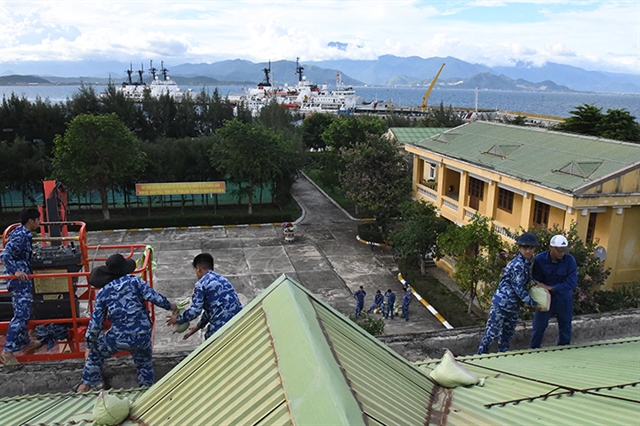 Society
Society

 |
| Coast Guard soldiers reinforce roofs of houses and offices. VNA/VNS Photo |
HÀ NỘI — Provinces and cities from Hà Tĩnh to Lâm Đồng, and ministries have been asked to prepare measures respond to Typhoon Kalmaegi that is forecast to approach to the East Sea (intentionally known as the South China Sea).
As of 4pm on November 4, the eye of Typhoon Kalmaegi was in the western sea area of central Philippines, about 770km east of Song Tử Tây Island.
The maximum sustained winds near the eye reached level 13 (equivalent to 134–149 km per hour), with gusts at level 16.
The storm is forecast to move west-northwest at around 25km per hour and may strengthen to level 14, gusting to level 17.
Upon landfall, it is expected to primarily affect provinces from Quảng Ngãi to Đắk Lắk, with gusts of level 14–15.
The storm’s circulation will bring extremely heavy rain to areas from Đà Nẵng to Đắk Lắk, ranging from 200–400mm, with some areas exceeding 600mm per event.
From southern Quảng Trị to Huế, Khánh Hòa and Lâm Đồng, rainfall is expected to be heavy to very heavy, ranging from 150–300mm, with some places over 450mm.
This is a very strong typhoon that will continue to intensify after entering the East Sea, with a wide impact area of strong winds. The Central Region is already suffering from historic, prolonged flooding that has caused severe damage.
To proactively prevent and respond to Typhoon Kalmaegi and subsequent flooding, ensuring people’s safety and minimising property damage both along the coast and inland, at sea, ministries and localities must closely monitor the storm’s developments and urgently inform ship owners, captains, and vessels operating at sea of the storm’s range and intensity so they can promptly move out of dangerous areas or seek safe shelter earlier than usual.
On land, localities must urgently repair damage from recent flooding, review and prepare evacuation plans for residents in high-risk areas — especially coastal zones, landslide-prone areas, flash-flood valleys, and deeply inundated regions — ensuring safe temporary shelter, food, and essentials for evacuees.
Schools in affected areas should be closed before the storm’s arrival and agricultural and aquaculture harvests should be accelerated under the motto “better a green home than a ripe field.”
Authorities must inspect vulnerable structures, unfinished works, and small reservoirs already full due to recent rains. Reservoir operators should urgently discharge water to create flood-storage capacity, especially in provinces expected to be hardest hit, from Quảng Ngãi to Đắk Lắk. They must maintain close supervision to ensure dam and downstream safety, and be ready to drain excess water to prevent agricultural flooding.
At the same time, the Ministry of Agriculture and Environment issued a dispatch to the People’s committees of Hà Tĩnh, Quảng Trị, Huế, Đà Nẵng, Quảng Ngãi, Gia Lai, Đắk Lắk, and Khánh Hòa, requesting urgent measures to ensure the safety of the dyke system in response to Typhoon Kalmaegi.
Local authorities must closely monitor storm and flood developments and the condition of dykes and embankments; promptly carry out reinforcement of vulnerable and critical locations, especially sea-facing sections, to limit damage.
They must prepare manpower, materials, and equipment for dyke protection under the “four on-the-spot” principle, ensuring the safety of the dyke system and immediately reporting any incidents to the Ministry of Agriculture and Environment for coordination and response. VNS




